Today we will take a look at one of the most asked question as a beginner in this sport: Is snowmobile dangerous? Snowmobiling, being a motorsport and a winter sport, is considered to be more dangerous than other sports out there. But, following the safety measures, it can be enjoyed without any incidents.
It’s one of the most entertaining motorsports, but we always need to think about safety first. Putting yourself in danger won’t make you look cool and the consequences can be disastrous. Snowmobiling, as any other sports, doesn’t come without risk of injury or even (much) worse, death.
When riding, you are in charge of your life. The snowmobile listens to your commands, so if you are a beginner, don’t throw yourself on the most dangerous terrain, don’t drive faster than you should be and don’t venture yourself into a dense forest riding at 80 mph. There is an old saying that puts this very clear: the snowmobile is only as safe as the driver. So you must use your common sense and ride for fun, being safe all the time, not to impress or look cool to others.
Types of Drivers
You may notice them all the time. I don’t talk about snowmobiles in particular here, but about all types of drivers including the usual car drivers. You may notice that some drive safe and other more aggressive.
Defensive Drivers
This is the type you should be. Even if you are a novice or having 20 years of experience you must be defensive when riding. Especially if you have experience, you must think a few moves ahead to prevent accidents with other less experienced drivers. You need to be alert all the time. Don’t let yourself fooled by the adrenaline pumping through your veins. So don’t let yourself surprised and your ride will be safe and great.
Here are some tips that you should follow to think and act like a defensive rider:
- Ice – yes, thin ice or even thick ice can be dangerous when riding. That’s why it’s on the top causes of snowmobile accidents
- Water
- Other fellows – Not everyone is experienced. You must keep the distance from the other snowmobiles in order to be able to break or steer in time to avoid the collision. I still remember those silly boys that pass 4 inches away from me when skiing just to show off. Not fun
- Roads – watch where your track ends. If your playground intersects a road, intersection or stops signs, you must be aware.
- Deep snow – can be dangerous as your snowmobile will behave unexpectedly.
- Trees – Riding near a forest or trees is dangerous especially for beginners. Also, watch out for fallen trees.
- Bridges
- Railway level crosses
- Dangerous objects under the snow – always inspect the track before doing a top speed run
- Animals
Aggressive Drivers
These types of drivers can be spotted without much effort. They just stand out from the crowd. Riding fast in crowded places, doing top speed runs near other trail users like skiers and snowboarders is the usual behavior. Be aware of this type of riders and try to be defensive. Don’t engage in their games or follow their lead. That’s just a reckless behavior that will most likely end badly. Not today, not tomorrow, but one day, they will feel the consequences.
What you can do is to spot these riders and keep the distance.
The rider
A Man
You’re a man! Congrats, if you don’t show off and put yourself in dangerous situations, you are pretty safe snowmobiling. You are not as fragile as the next categories.
A Woman
We must admit women are not as good drivers as men (or can be, who knows). If you’ve never ridden a snowmobile before, always drive slow and on safe terrain like plain snow.
A Pregnant Woman
Well, here the things get a lot more complicated. Depending on the type of pregnancy, condition and month you are in, you may or may not be able to ride a snowmobile safely. If you have any special conditions or carrying multiple babies don’t even think about it. It’s just not safe, as riding a snowmobile includes a lot of shocks caused by bumps.
While there are some benefits and you must be active during pregnancy, snowmobiling is often considered too dangerous. If you are in the first, second or maximum third month and your pregnancy don’t have any medical conditions associated you can do it. Note that this is my advice and doesn’t substitute the advice of your medical doctor. Always ask your doctor before taking the decision to ride a snowmobile or any sport. Your doctor can give you the best advice you can get.
A Kid
Kids need some special attention and they shouldn’t ride unsupervised. Get a suitable sled for them keeping in mind their age. Choosing the right dimensions for the snowmobile will allow the kid to handle and control it well.
Snowmobiling is a harsh sport, you need to be strong in order to control it well. If you go on difficult terrains it is difficult for a kid to control the sled in a safe manner.
As a rule of thumb, kids under age 6 should not be taken as passengers. This is because being a passenger is often more difficult than riding a snowmobile. It requires a strong and firm grip and you need to hold tight for a long period of time, which can be difficult for a 6-year-old.
It depends on the terrain of course. If you ride on a flat terrain at slow speeds, it’s not that hard to ride and hold on to the rider. But if you go on a bumpy, ice terrain this task can get pretty difficult.
Believe it or not, injuries are most common in passengers than in riders. Being able to hold on tight for a long period of time is not easy. Lose the grip and you could get a pretty nasty head injury.
I don’t want to scare you, but if your child falls off the snowmobile or worse, the snowmobile rolls over them, the injuries can be deadly.
Anyway, be prepared and take all the necessary safety steps like buying protective boots, a neck brace, good helmet etc. Also, supervise your child carefully.
(https://www.caringforkids.cps.ca/handouts/snowmobiles)
Terrain and Location
Terrain and location are the most important factors that can influence the safety of your ride. We will explore different types of terrains in order to see how dangerous are they.
Also, the location matters because of the weather which can get ugly pretty fast in some areas. Another factor is the surroundings, for example, it is much more dangerous to ride near a forest than on a flat terrain without bumps. Besides the obvious trees, forests are pretty good at hiding bumps and other obstacles like animals, fallen branches, etc.
Avalanche, for example, is a leading cause of fatalities in all types of winter sports. We need to be aware and be prepared for it when going in an avalanche-risk area. We need to pay close attention to weather news and ask the locals.
Snowmobiling in Snow
Going on a flat snow terrain is the safest way to ride and enjoy your snowmobiling. You can predict most of the things when riding on a flat surface. If you are a beginner, this is your starting point. I know riding on ice or in deep snow is more fun, but you need to learn the basics first before seeing your sled rolling over you.
Snowmobiling in Deep Snow
Deep snow is clearly more dangerous than a flat surface as it hides bumps, obstacles and the ability to predict and control disappears. Your snowmobile will go in which direction it wants and won’t listen to you as closely as on a flat terrain.
If you are a moderate or advanced rider, you can try this type of terrain, but begin light. Going directly into a 9 foot deep snow for the first time is probably not the best idea.
Another thing that can happen in deep snow is getting stuck. Ask every experienced rider and you can find that it happened to him at least once. Getting in is the easy part, getting out is the problem. Like discussed in other articles, and I suggest reading this in particular, getting out is easy when you have some friends with you.
If you ride alone, it’s probably a good idea to have a first aid kit, thick clothes, and a GPS to prevent dangerous situations.
Snowmobiling on Ice
Snowmobiling is certainly a great sport, but certain conditions like ice, for example, can put you in great danger. The best advice is to avoid riding on ice on top of a lake for example. But if you really want to, you must check with the locals about the ice condition. Even checking with the locals won’t guarantee that the ice is safe to ride. When talking about ice, nothing is guaranteed, so better safe than sorry.
If you insist riding on ice, at least get some friends with you. Riding in a gang, you will be safer as the other can help you if something happens.
If ice brakes, that will lead to a panic. But you must be prepared and you must control your feelings. Following some basic steps will prevent a bad outcome:
-
- Don’t worry about the snowmobile. Your life is more valuable than a piece of steel (it sound harsh, but it’s true).
- Swim to the nearest ice edge by doing horizontal moves with your legs and hands
- Get yourself on the ice, but don’t stand up as the ice can break. Roll-over to a safer place where the ice is strong. If you feel the ice is thick and strong, move using your hands and legs gently (on all fours).
- Next step is to dry yourself. Find a safe place, and take your wet clothes off. (Read more on the article: What to do if you sink your snowmobile. There you will find how to dry yourself and avoid hypothermia)
- Only after you are safe and warm, think about how to get your sled out of the freezing water (Again, refer to the article above for a quick solution)
Riding on ice is one of the most often causes of snowmobiling accidents. So, avoid frozen lakes and rivers as much as possible.
This leads to another cause of fatalities that we will discuss forward: drowning.
Riding the snowmobile on Water!
I saved the best for last. Just kidding, snowmobiling on water is the most dangerous things you can do. Even if you have enough experience and skills, it’s a hard task. If I got a penny for every rider that got his snowmobile sunk together with him of course, I would have been rich! Unfortunately, it’s not the case, but you get the point.
Be aware that I strongly suggest you don’t try this. If you do, your life is at stake!
- Always get some friends with you if trying this
- Get an extra pack of (dry) clothes waiting for you
- Save yourself first, your sled can wait
Riding snowmobile on grass
Riding snowmobile on grass is clearly fun for some. I think it’s because of the lack of patience for the snow. Seeing the dust sitting on your sled is not fun and some will do anything to get some adrenaline.
For me, riding on snow is much more interesting and safe. If you don’t care about your skis wearing off, go ahead. First, you will need to lubricate your skids to prevent scratching and even destroying your skis forever. Also, going on a wet grass is safer for your skiis than on dry.
Your snowmobile will head pretty fast and some snowmobiles go in limp mode to prevent you from destroying them.
So as final tips:
- Lubricate your skis
- Ride only on wet grass, or try to go over wet areas most of the time
- Drive slow to prevent excessive heating.
- If you smell burning plastic, it’s time to stop
- If your engine goes in limp mode (because of engine overheat) stop immediately
- Be aware that you won’t be able to control the sled well. Turning on dry, or even wet grass is a difficult task
! Don’t try this at home disclaimer: Don’t do it on your own lawn, the chances are you will pretty much ruin it!
Riding snowmobile on Dirt
It’s probably worse than grass, besides not having much control of direction, your skis and the engine will heat up pretty fast. Again, if you really want to do this, at least lubricate your skis and follow the same tips for the grass run.
You can severely scratch your skis and they may need replacement after a few runs. Anyway, it’s better to ride on wet dirt (if you really need to), the same as grass.
Riding snowmobile on fog weather
Riding a snowmobile on fog weather can be dangerous as the visibility is greatly reduced. It depends on the visibility which is measured in length (feet or meters) to the objects in order to clearly discern them.
Low visibility typically refers to a sight under 100m or 330ft and is often specified as 0 (zero) visibility. A visibility of under 100-300 meters (approx. 330-1000 feet) is considered very dangerous for riding a snowmobile because you can’t break and steer in time.
Just imagine that at 36 kilometers per hour you go 10 meters/second.
At 60 kilometers per hour, you go with 16 meters/second
At 90 kilometers per hour, you go with 25 meters/second.
Let’s switch to miles:
20 miles per hour – 29.3 foot/second
45 miles per hour – 66 foot/second
80 miles per hour 117.333 foot/second
How fast can you react if a deer jumps before you? If you ride on a fog weather, you need to adapt your speed to the environmental conditions. Try to ride slower than usual and keep your headlights and taillights on. If you have fog tail lights installed that’s great because others can see you in time.
Day vs Night Snowmobile Riding
Obviously, night riding is more dangerous as you have little visibility. Even with the greatest headlights, your visibility is reduced. Spotting obstacles and bumps in time will be very hard, so again, ride slower than usual and inspect the track before riding with speed.
If the track is illuminated than, there is little difference from day-time conditions.
It is said you can see a lighting candle in dark at as far as 48 kilometers. So, if your friends have tail lights, and it’s not foggy, you could easily spot them. The problem is with other obstacles that don’t conveniently have a tail light attached like trees, bumps, wild animals, abyss etc. Your headlights offer you limited visibility and at high speeds, there is likely you can’t react in time to a non-expected obstacle. Let’s look at the video below, it was taken at night. You can see there is a limited visibility.
[Video]
Always make yourself visible using the headlight and taillight. Also, lower your speed to the conditions and make sure you have enough time to react to what’s ahead.
Safety Measures
What safety measures can we take to feel safer when riding a snowmobile? Well, there are plenty:
- If you are a beginner, take a snowmobiling safety course: it can teach you how to ride defensively avoid obstacles and how to react to dangerous situations
- Always check the weather and check with the locals. Especially in avalanche risk areas
- Be a defensive rider (read the tips in the dedicated section above)
- Don’t drink, do drugs or ride when tired or feeling ill. If you use drugs that can affect your riding abilities, consult with your medical doctor first
- Wear protective gear all the time: Helmet, neck brace, boots etc.
- Snowmobile maintenance check before going on a trip
- Bring more experienced friends with you
- Have a first aid kit with you – Read more on this post
- Avoid dangerous terrains and weathers like the ones explained above. If you are a beginner, ride only on flat terrain
- Stay on marked trails – Besides being monitored (usually), they are much safer
- Make yourself visible with Headlights and Taillights
- Don’t pull anyone with your snowmobile. Most snowmobiles are not made for this and a lot of accidents could happen
- Don’t overload your snowmobile
- Follow the rules
- Don’t go too fast and adapt to the environmental conditions
- Stay alert and watch for dangers
- Read the safety labels on your snowmobile
- Keep a distance between sleds
- Don’t ride on unfamiliar terrains at night
- Watch out for crossings, roads, railways
How to feel and be safe when changing direction?
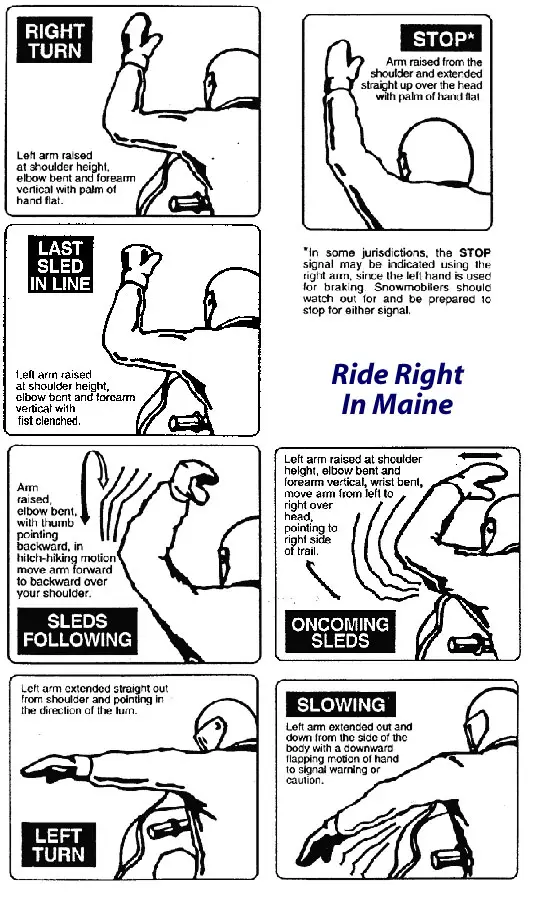 If you want to change direction on a track with other riders make sure other riders can see you well in advance. There are universal signs that you can make when changing directions or stopping. There are as follows:
If you want to change direction on a track with other riders make sure other riders can see you well in advance. There are universal signs that you can make when changing directions or stopping. There are as follows:
- To stop: Raise your left arm straight up
- To turn left: Extend your left arm straight to the left
- To turn right: Place your left hand out and turn it upward in order to form a 90-degree angle
- When snowmobiles are approaching you can let other riders know by waving your left hand. It’s just like a right turn, but you keep moving your hand to almost touch your helmet. This is useful because they need to stay on the right on the trail when other riders approach.
You need to think ahead and let other riders what intentions do you have well in advance. Rising your hand in the last second won’t do any good as they may not react that fast.
Signs
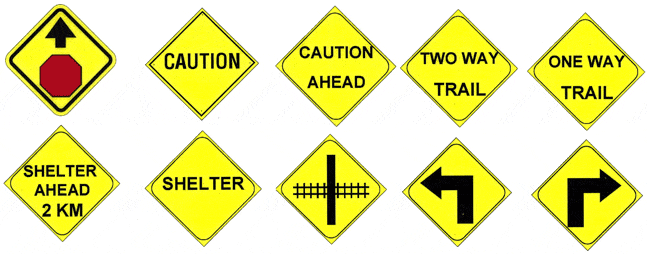 Besides riders signs, there are other signs available on the marked trails. Most of them look like road signs and are usually dark orange. They can warn us if there is a dangerous corner approaching if snowmobiling is restricted in the area, animals etc. Also, on most marked tracks, there are directional markers that help you follow the proper trail.
Besides riders signs, there are other signs available on the marked trails. Most of them look like road signs and are usually dark orange. They can warn us if there is a dangerous corner approaching if snowmobiling is restricted in the area, animals etc. Also, on most marked tracks, there are directional markers that help you follow the proper trail.
Other common signs:


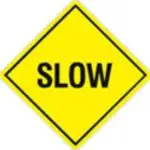
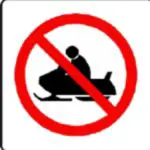
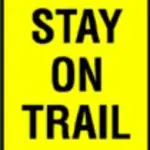



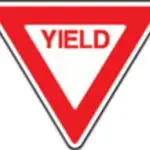
Driving Tips
Besides being a defensive driver and following the signs and rules there are some driving tips:
- Most of these refer to some basic riding techniques and how to approach different situations like steering, breaking etc.
- Sitting position is preferred in most situations as it gives you stability
- Both feet should be on the footrests and both arms on the handlebars
- Switch to a knee flex position or upright position when going over bumps or difficult terrain
- Swift your body weight in the direction you are turning, just following the corner. This is required in order to keep the snowmobile balanced.
- If you have a passenger, ask him to do the same thing, otherwise, the balance of the snowmobile could shift in an unwanted direction and lead to accidents
- Don’t try to challenge yourself with difficult maneuvers if you don’t have enough experience for them. Learn and master the basics first
Accidents
Just don’t do like these guys in the video
Snowmobile accidents statistics
I took a look at the death statistics I could find on the Internet. So it looks like there were about 14000 injuries caused by snowmobile accidents in one year in North America. The causes are many, but if you look at them closely, you can see these injuries happen because some rules are not respected.
I found some report for snowmobiles fatalities in Wisconsin in the 2017-2018 period. Most of the causes (almost all) had alcohol involved in the story. As the actual, physical cause, on almost all accidents the cause was that the rider struck a fixed object or another snowmobile.
Take a look here for the full report.
Snowmobile death statistics
But, how many snowmobile deaths are per year? Well, a lot, it is reported that there were 200 deaths in North America in one year. This number beat my expectation and I can’t believe such an enjoyable sport causes 200 deaths per year only in North America. But the causes are the same: alcohol and drug consumption, excessive speed.
But there are indeed factors that don’t include following the rules. Rules are there to help us, but they can’t prevent anything. Multiple injuries and deaths were caused simply by inexperienced drivers or poor judgment. If you want to read the whole statistics article go here.
Snowmobiles vs. ATVs vs UTVs
I found a study in regards to snowmobile and ATV fatalities from the 2007-2012 period. This doesn’t refer to the US, but Sweeden. But I think the averages are the same everywhere.
This article says there were 107 fatalities as follows:
- 57 snowmobile related
- 50 ATV related
But we need to look at their popularity as well in order to get a percentage. It seems that snowmobiles are much popular in Sweeden than ATVs. Probably due to their climate. So here are the numbers:
Snowmobiles:
- 177,000 in 2006
- 223,000 in 2011
ATVs:
- 36,000 in 2007
- 91,000 in 2012
So, from these statistics, it seems that the snowmobile is safer than ATVs as there much more snowmobiles out there than ATVs and the numbers of fatalities are close.
The UTVs are probably much safer though, I didn’t find a good comparison study.
Read the full study here.
Conclusion
In my opinion, riding responsibility and safety is much more fun than trying to show off, and put yourself in dangerous situations just to get some adrenaline. Your body and life are at risk when snowmobiling, so we need to take this seriously. Follow all safety tips and you will enjoy your ride.
In some states, there are some special laws or rules that apply to snowmobiles. Be aware of them and follow those as well.
